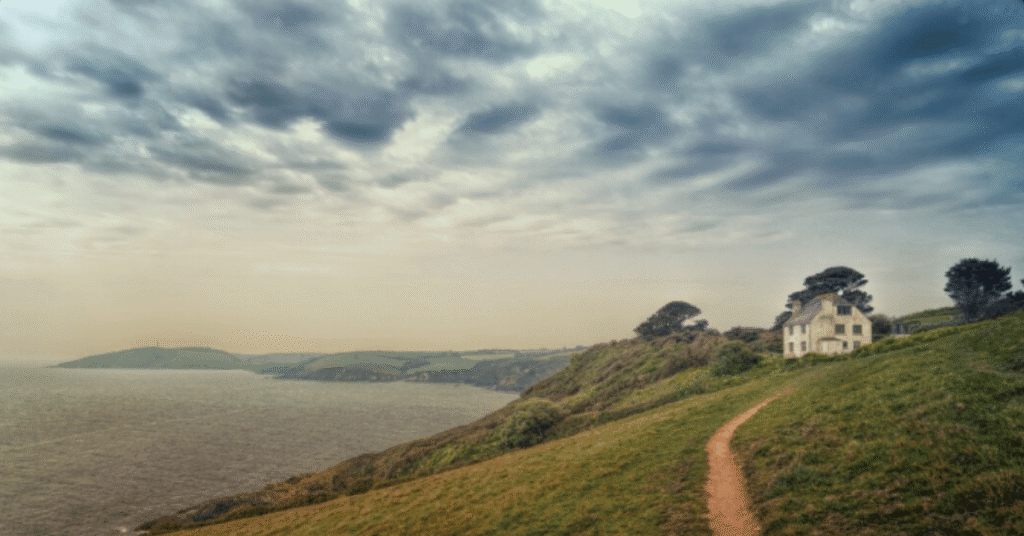Tucked deep within the rolling green embrace of Gloucestershire, Sapperton Cotswolds is one of those English villages that seem to pause time itself. For travelers seeking authenticity beyond tourist trails, Sapperton offers an intimate view of English rural life, architectural grace, and the enduring spirit of craftsmanship. Within the first few minutes of walking its stone lanes, the visitor realizes that this is not just a village but a living memory of the Cotswolds’ cultural essence. It’s a place where historic cottages stand quietly among beech woods, and where the creative legacy of the Arts and Crafts movement still hums beneath the rhythm of daily life. The charm of Sapperton Cotswolds lies not only in its landscape but in the way it connects history, architecture, and the human spirit — a serene blend that makes it one of England’s best-kept secrets.
Visitors often arrive expecting quaintness but leave having encountered something far more profound: a landscape that tells stories. From its ancient church and canal tunnel to the echoes of designers like Ernest Gimson and the Barnsley brothers, Sapperton is a quiet testament to rural artistry. Its cottages whisper of centuries-old craftsmanship, its woodlands evoke a deep ecological balance, and its pathways invite contemplation. “Sapperton is not just a village,” once wrote British art critic Clive Bell, “it is a meditation on beauty itself.” The Cotswolds has many picturesque settlements, but few preserve the philosophical soul of England’s countryside quite like Sapperton does.
The Timeless Heritage of Sapperton
Sapperton’s story reaches back over a thousand years, woven into the tapestry of early Gloucestershire life. Its name, thought to derive from “Sæppa’s Farmstead,” reflects its Anglo-Saxon roots. Yet what makes Sapperton unique is its deep association with craftsmanship and rural architecture. By the late 19th century, it became the spiritual home of the Arts and Crafts movement, led by figures who believed that beauty and labor should coexist. The village became an open-air workshop for artisans who rejected industrial uniformity.
The church of St. Kenelm, standing quietly at the heart of Sapperton, serves as both a historical anchor and a creative emblem. Inside, one finds memorials carved by local craftsmen whose work reflects the ideals of design honesty. The nearby Daneway Inn, a centuries-old public house, once hosted stone masons, poets, and carpenters whose artistry shaped both furniture and thought. Sapperton’s streets, lined with golden limestone cottages, reveal the kind of hand-built precision that defines the Cotswolds’ heritage — humble, enduring, and elegant in every proportion.
The Artistic Spirit of the Cotswolds
At the dawn of the 20th century, Sapperton became the nucleus for the Arts and Crafts colony. Ernest Gimson, Sidney Barnsley, and Ernest Barnsley settled here, building homes that embodied their principles: simplicity, utility, and beauty. Their workshops attracted a small but devoted community of woodworkers, metalworkers, and designers who sought to restore the dignity of manual creation.
In Sapperton, artistry was not decoration; it was philosophy. Each joint, each curve, each wooden grain was considered an expression of respect toward nature. The Sapperton craftsmen rejected factory production, instead creating bespoke furniture and fittings that celebrated human touch. Their influence extended far beyond Gloucestershire, shaping British design and inspiring generations of makers. “Craftsmanship in Sapperton was a kind of prayer,” noted historian Fiona MacCarthy. “Every object carried the soul of its maker.” This legacy still breathes in local workshops and restored houses that keep the movement alive.
Landscape and Natural Harmony
Sapperton sits amidst a quintessential Cotswolds landscape — gentle hills, patchwork fields, and beech woodlands that glow amber in autumn. The area’s ecological integrity has remained surprisingly untouched, offering a rare sense of peace. The village lies near the ancient Sapperton Valley, where wildlife flourishes: deer, songbirds, and wildflowers coexist with traditional farming. The Cotswold limestone creates a luminous quality of light that artists often find irresistible.
For walkers, the Sapperton Valley Trail and the Thames & Severn Canal path offer a meditative journey through rural England. The Sapperton Tunnel, an 18th-century engineering marvel, lies hidden beneath the landscape, once connecting local industries to national waterways. The contrast between this man-made ingenuity and the surrounding pastoral calm is striking. Every step here feels like a bridge between human endeavor and natural grace — a union that defines Sapperton’s essence.
Table 1: Key Attractions in Sapperton Cotswolds
| Attraction | Description | Historical Significance | Visitor Experience |
|---|---|---|---|
| St. Kenelm’s Church | Medieval parish church with Arts & Crafts memorials | Reflects 13th-century architecture | Serene and contemplative |
| Sapperton Tunnel | Historic canal tunnel built in 1789 | Engineering feat of its time | Walks and heritage interest |
| Daneway Inn | 17th-century inn surrounded by woodlands | Gathering place for craftsmen | Cozy local dining |
| Gimson House | Former home of designer Ernest Gimson | Center of Arts & Crafts legacy | Private residence, visible from road |
| Sapperton Valley Trail | Walking path through meadows and woods | Ecological preservation route | Ideal for nature walks |
Architecture and Craftsmanship
Sapperton’s architecture represents more than aesthetics; it embodies the Cotswold philosophy of integrity in design. The cottages here, built from honey-colored stone, follow natural contours rather than rigid plans. Roofs are steeply pitched with local stone slates, and windows are modest yet perfectly proportioned. The legacy of Gimson and the Barnsleys remains visible in timber framing, ironwork, and garden layouts.
The village hall and restored farmhouses reveal a consistency of tone that few modern villages maintain. Builders used traditional lime mortar, wooden pegs, and local materials that breathe with the seasons. Even new additions respect the organic balance of the landscape. In a world increasingly shaped by uniformity, Sapperton’s architecture reminds visitors that beauty often lies in imperfection — in the visible mark of human labor and intention.
The Social Fabric of the Village
Although Sapperton is small, its community spirit is deeply rooted. The village population has remained modest, preserving a sense of intimacy and shared responsibility. Local gatherings, seasonal fairs, and conservation projects are central to village life. Residents often participate in maintaining walking paths, restoring dry-stone walls, and nurturing gardens that attract both pollinators and visitors.
There is a quiet pride among the villagers, who see themselves as stewards rather than owners of heritage. Many families trace their lineage through centuries of farming and craftsmanship. This blend of continuity and collaboration creates a rare authenticity. “You don’t live in Sapperton,” a local farmer once said, “you belong to it.” This sense of belonging is perhaps the most valuable part of Sapperton’s charm — an unbroken thread between past and present.
Modern Sapperton: Balancing Preservation and Progress
Today, Sapperton walks a delicate line between heritage preservation and modern life. Tourism has grown, yet it remains sustainable and respectful. The absence of large-scale commercialization allows the village to retain its quiet dignity. Visitors can stay in eco-lodges or restored cottages that blend traditional aesthetics with modern comfort.
Many contemporary artisans have returned to Sapperton, inspired by its legacy. Woodworkers, potters, and textile artists operate from small studios, often collaborating on community exhibitions. The Sapperton Arts Festival, held annually, celebrates this creative continuity with workshops, installations, and performances. Unlike many tourist destinations, Sapperton resists superficial modernization. Instead, it thrives on authenticity, inviting people to experience rural England as it truly is — grounded, graceful, and alive.
Table 2: Cultural Events and Community Activities
| Event | Description | Time of Year | Community Involvement |
|---|---|---|---|
| Sapperton Arts Festival | Celebration of crafts, music, and design | Summer | Artists and local makers |
| Harvest Fair | Traditional rural fair with stalls and games | Autumn | Entire village participation |
| Heritage Walks | Guided tours through historic routes | Spring & Fall | Local historians |
| Green Stewardship Program | Conservation and rewilding initiatives | Year-round | Volunteers and residents |
| Candlelit Carol Evening | Festive gathering at St. Kenelm’s Church | Winter | Choir and villagers |
A Destination for Reflection
What makes Sapperton truly compelling is not merely its history but the emotion it evokes. Travelers often describe a sense of stillness that feels increasingly rare in modern times. The quiet roads, the distant call of wood pigeons, the scent of moss after rain — all create an atmosphere conducive to reflection. Artists, writers, and thinkers find in Sapperton the solitude they need to create.
It is easy to see why the village continues to inspire. Its gardens bloom in layered harmony, its stone walls echo centuries of endurance, and its landscape offers the simplicity that modern life often lacks. To visit Sapperton is to encounter not just a place but an idea — that beauty, craftsmanship, and community can coexist without noise or haste.
Visiting Sapperton: A Traveler’s Perspective
Reaching Sapperton is part of the experience. The narrow roads wind through fields dotted with sheep and dry-stone fences. Nearby towns such as Cirencester and Stroud provide easy access, while the surrounding countryside offers numerous walking and cycling routes. Accommodation options range from country inns to self-catering cottages, all designed to reflect the Cotswold aesthetic.
Visitors are encouraged to explore respectfully, mindful of private properties and conservation areas. The best times to visit are spring and autumn, when the landscape is at its most colorful and the light turns golden across the valley. Whether you come for a day trip or a quiet weekend, the village leaves an impression that lingers long after you leave — a memory of tranquility.
Quotes that Define Sapperton
- “In Sapperton, time is not lost — it simply slows down to breathe.” — Anonymous Visitor
- “Craftsmanship here is more than skill; it’s a dialogue between human hands and English earth.” — Fiona MacCarthy
- “To walk through Sapperton is to read poetry written in limestone.” — Local Historian, 1998
Conclusion
Sapperton Cotswolds is not just another stop on a traveler’s map — it is an experience woven from England’s cultural DNA. Its enduring beauty lies in its ability to connect people to something timeless: a reverence for craftsmanship, community, and the natural world. While cities expand and modern life accelerates, Sapperton remains a sanctuary for thought and simplicity. It stands as proof that heritage, when cherished, does not become obsolete but rather becomes a compass for the future. For those seeking the soul of the Cotswolds, Sapperton is not a destination — it is a return to the very heart of beauty itself.
FAQs
1. What makes Sapperton unique among other Cotswold villages?
Sapperton stands out for its deep association with the Arts and Crafts movement, blending rural simplicity with artistic integrity. Its heritage buildings, landscape, and enduring craftsmanship create a uniquely authentic atmosphere.
2. Can tourists stay overnight in Sapperton?
Yes, Sapperton offers charming accommodations, including country inns, converted cottages, and nearby lodges, all reflecting traditional Cotswold design while providing modern comfort.
3. Is Sapperton accessible for day trips from major cities?
Absolutely. Sapperton is easily reachable from cities like Bath, Cheltenham, and Oxford, making it ideal for weekend visits or scenic countryside drives.
4. What are the best times of year to visit Sapperton?
Spring and autumn are the most picturesque seasons, showcasing blooming wildflowers, golden foliage, and pleasant weather for walking and exploring.
5. Does Sapperton host any local festivals or cultural events?
Yes, the annual Sapperton Arts Festival and seasonal fairs celebrate craftsmanship, heritage, and community life, continuing the village’s creative tradition.







